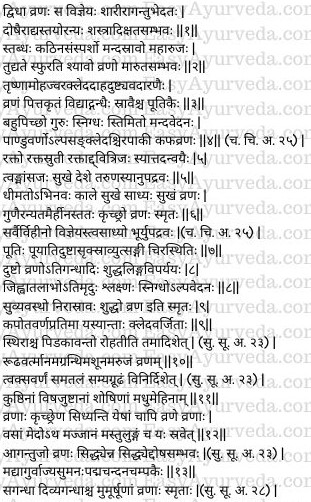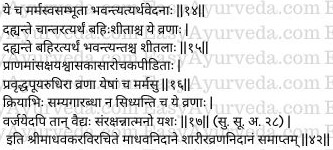Madhava Nidana Chapter 42 Shareera Vrana Nidanam
This article explains Madava nidana 42nd chapter “Sharira Vrana Nidanam”. Causes, pathology and symptoms of Sharira Vrana are explained in this chapter.
Read – Charaka Vrana Chikitsa – 25th Chapter – Wounds, Ulcers

Table of Contents
Vrana Bheda
Types of Vrana
Vraņas (ulcers) are of two kinds. They are –
- Sharira Vrana – physical or organic ulcers and
- Aagantuja Vrana – traumatic ulcers
The first one i.e., saririka vrana is caused by the doshas. The second type i.e., agantuja vrana is caused by injury caused by weapons, sharp instruments etc. (1)
Read – Nadivrana – Sinus: Types, Symptoms, Ayurvedic Treatment
Lakshanas
Symptoms of types of sarira vranas
Vataja Vrana – The ulcer caused by vitiated vata is immobile (stiff), hard on touch, has less discharges (scanty exudation) and severe pain. The pain is of pricking or pulsating type. The ulcer is of bluish black colour.
Pittaja Vrana – The ulcer caused by vitiated pitta is associated with thirst, delusion (fainting, unconsciousness), fever, wetness (due to secretions), burning sensation, dirty, pain as if being torn (cracking of skin or tendency to burst open quickly), emits bad smell and discharges foul smelling secretions.
Kaphaja Vrana – The ulcer caused by vitiated kapha is excessively sticky, heavy, unctuous (oily), and feels as if covered by wet leather or cloth. The ulcer will be slightly painful, pale (yellowish white) in appearance, less moist, and suppurates slowly.
Raktaja Vrana – The ulcer caused by vitiated blood will be red in colour and will discharge only blood.
Dwija / Dwidoshaja Vraņa – This is caused by combination of two doshas and will have combined symptoms of those two doshas involved.
Trija / Tridoshaja Vrana – This is caused by a combination of all three vitiated doshas and will have combined symptoms of all three doshas together. (2-4)
Read – Injury, Wound care Ayurvedic Remedies, Medicines
Sadhyasadhyata
Prognosis of Sarira Vrana
Ulcers are curable when they –
- are located in the skin or muscles,
- are located in a convenient place (places of the body other than marmas – vital spots),
- occur in a young person,
- are not associated with complications,
- occur in intelligent persons (those who can discriminate between good and bad)
- are of recent origin,
- occur in appropriate time i.e., favorable season, age etc. (mainly Hemanta and Sisira – late and early winter) (5)
Those (physical ulcers) which possess a few of the above qualities (few qualities less than those mentioned above – in the curable category) are difficult to cure. On the other hand, those which are devoid of any of the above-mentioned qualities (of curable ulcers) and also associated with many severe complications are incurable. (6)
Read – How To Make Prognosis Of Disease According To Ayurveda?
Dusta Vrana (bad, contaminated ulcer) Symptoms
Dusta vrana (bad, intractable ulcer) is one which discharges the blood heavily contaminated with foul smelling pus, has sinuses inside it, remains for long periods, has excessive foul smell, discoloration, discharges and pain and possesses opposite qualities of a clean ulcer. (7)
Shuddha Vrana (clean ulcer) Symptoms
A shuddha vraṇa (clean ulcer) is one which is very soft like the upper surface of the tongue, smooth, unctuous (moist), with mild pain, even (without sprouts and sinuses) and without excessive discharges (exudation). (8)
Ruhyamana Vrana (ulcer in the stage of healing) Symptoms
The edges of a ruhyamana vraṇa (ulcer) i.e., the ulcer in the stage of healing has the colour of a pigeon (slightly blackish white) and is devoid of moistness. The ulcer is fixed and is studded all around by granulations. (9)
Samyak Rudha (ulcer which has healed) Symptoms
The ulcers in which the edges have closed up (ulcer is filled up with granulation tissue indicating that it is healed), which does not have knots (elevations), which is devoid of swelling or pain, which has attained the normal color of the skin, and that which is levelled is considered to be a samyak rudha vrana i.e., the ulcer which has healed up. (10)
Read – Sushruta’s 8 Types Of Surgical Procedures – Astavidha Shastra Karma
Prognosis of Vranas
Vranas (ulcer) heals with great difficulty in persons who are suffering from leprosy, poisons, tuberculosis and diabetes mellitus. The ulcers in which ulcers develop should also be considered as difficult to cure.
The ulcers which are caused by trauma and discharge muscle fat, fat, bone marrow or brain tissues (brain matter) etc. are curable. On the other hand, if this is caused due to the aggravation of doshas, it is incurable. (11-12)

Arista Lakshanas
Signs of ulcer indicating bad prognosis
Vranas (ulcers) which emit a smell similar to alcohol, aguru (Aquilaria agallocha), ghee, flower of jasmine or lotus, sandalwood, campaka flower and such other pleasant / divine smells are going to kill the patient. (13)
Other symptoms of incurability of ulcers
Below mentioned are the other symptoms of incurability of ulcers –
- Vranas (ulcers) having severe pain in spite of not manifesting on vital organs,
- Ulcers having severe burning sensation inside and are cold outside
- Ulcers having severe burning sensation outside but are cold inside
- Ulcers manifesting in those having loss of strength, loss of muscles (emaciation), dyspnoea, cough, and loss of taste (appetite)
- Ulcers discharging large quantities of pus or blood
- Ulcers occurring on the vital spots of the body
- Ulcers which are not responding to any kind of treatment (ulcers not getting healed in spite of administering best of well-planned treatments)
All these kinds of ulcers shall be rejected (should not be treated) by a physician who does not want his reputation to be damaged. (14-17)
Thus ends the chapter on Shareera Vrana Nidanam in Madhava Nidana text written by Acharya Madhavakara.











